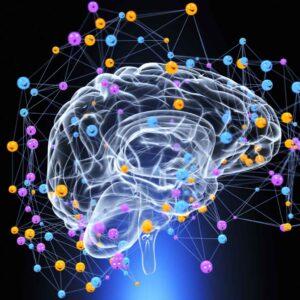Types of Neurodiversity: Autism, ADHD, Dyspraxia, Dyslexia and More
June 12, 2025
Complete guide to types of neurodiversity including autism, ADHD, dyslexia, and dyspraxia. Discover strengths, challenges, and how to create inclusive environments.
Understanding Neurodiversity

Neurodiversity celebrates the natural variation in how human brains function, encompassing conditions such as autism, ADHD, dyslexia, dyspraxia, and other types of neurodiversity conditions. This concept challenges the traditional “neurotypical” model—a social construct that suggests there’s a single “normal” way brains should work.
Neurotypical refers to individuals whose neurological development aligns with societal expectations, but this idealised concept is just that—a construct. In reality, all brains are unique, and types of neurodiversity represents valuable human diversity that should be celebrated rather than seen as deviation from a norm.
Neurodivergence describes individuals whose brains function differently from societal expectations. Being neurodivergent isn’t a disorder or deficit—it’s a natural variation that often comes with unique strengths in thinking, problem-solving, and perception, alongside challenges that can be addressed through understanding and support.
These differences in cognitive processes, sensory sensitivities, and behaviours reflect diverse neurological approaches to processing information and interacting with the world. Rather than viewing these as “symptoms,” we recognise them as different ways of being that contribute meaningfully to society. Understanding the variations of neurodiversity is essential for creating neuroinclusive environments where neurodivergent individuals can thrive, whether in educational, professional, or social settings. This approach benefits everyone by encouraging diversity of thought, improving innovation, and supporting mental health and wellbeing.
What are the main types of Neurodiversity?
Learn about the main types of neurodiversity, including autism, ADHD, dyslexia, and dyspraxia. Understand how neurodivergent individuals experience unique strengths and challenges.
The main types of neurodiversity include conditions such as autism, ADHD (attention differences), dyslexia, dyspraxia, and more. Each condition presents its own set of strengths and challenges that can significantly shape an individual’s experiences in various aspects of life. These differences are not disorders but variations in brain function that contribute to the rich diversity of human cognition.
In this section, we’ll explore the key types of neurodivergent conditions, how they typically manifest, and the common traits they share. Understanding these conditions is the first step towards creating more inclusive environments that support neurodivergent individuals.

Main Neurodivergent Conditions & Traits
Autism Spectrum
Learn about the autism spectrum, how it affects communication and social interaction, and discover common related neurodivergent conditions associated with autism.
Autism is one of the most well-known neurodivergent conditions. It exists on a spectrum and affects social interaction, communication, and behaviour. People on the autism spectrum may exhibit a range of behaviours, from intense focus on specific interests to difficulty in social situations or understanding non-verbal cues.
Autism is often accompanied by sensory processing differences, such as heightened or reduced sensitivity to sights, sounds, and touch. These sensory differences can impact daily life and contribute to sensory overload or discomfort.
Strengths of Individuals with Autism:
- Exceptional attention to detail
- Specialised knowledge
- Logical and analytical thinking
- Honesty
- Unique perspectives
- Strong memory
- High focus and perseverance
- Reliability
- Creativity
Visit our Autism page for a fuller explanation and lived experience.
Related Conditions with Autism
Alexithymia
Alexithymia is frequently associated with autism and refers to the inability to identify and describe one’s emotions. This can lead to challenges in emotional regulation and communication, making it harder to navigate social situations and relationships.
Hyperlexia
Hyperlexia refers to an advanced ability to read at an early age. However, it is often accompanied by difficulty in understanding spoken language or social cues. Hyperlexia is commonly observed in children on the autism spectrum and can sometimes be linked with other neurodivergent conditions, such as attention differences (ADHD).
Stimming
Stimming (self-stimulatory behaviour) refers to repetitive movements, sounds, or actions that help individuals self-regulate or cope with sensory overload, anxiety, or excitement. Stimming is particularly related to autism and other neurodivergent conditions. Stimming can include actions like hand-flapping, rocking, or repeating certain sounds or phrases. While stimming serves as a coping mechanism, it can also help individuals express emotions or focus their attention.
Autism & Co-occurring Traits
Autism often coincides with other types of neurodivergence, including ADHD (attention differences), dyspraxia, dyslexia, and dyscalculia. These overlapping conditions can further shape how individuals experience the world and navigate daily life.
Attention Differences ADHD
Understand ADHD, its types (inattentive, hyperactive-impulsive, combined), and how attention differences shape unique strengths and challenges in neurodivergent individuals.
Attention differences are officially described as Attention Deficit Hyperactivity Disorder (ADHD), a neurodevelopmental condition characterised by persistent patterns of attention challenges that interfere with daily functioning or development. ADHD affects both children and adults, though its symptoms may present differently depending on age and individual circumstances.
Three primary types of ADHD
Each is defined by the symptoms that are most prominent:
- Inattentive Type: Individuals with this type may have difficulty staying focused, following instructions, organising tasks, and completing work. They may appear forgetful or distracted.
- Hyperactive-Impulsive Type: Individuals with this type may struggle with restlessness, difficulty sitting still, excessive talking, and impulsive decision-making or actions without considering the consequences.
- Combined Type: This type includes symptoms of both inattention and hyperactivity-impulsivity.
For more detail and lived experience examples click here.
ADHD Strengths include:
- Creativity
- Hyperfocus
- High energy
- Cognitive flexibility
- Leadership skills
- Problem-solving skills
ADHD & Co-occurring Traits
Attention differences (ADHD) often overlap with other neurodivergent conditions, such as dyspraxia, dyslexia, dyscalculia, and autism, which can influence how individuals navigate daily life and interact with their environment.
Dyspraxia – Developmental Coordination Disorder (DCD)
Learn about dyspraxia, also known as Developmental Coordination Disorder (DCD), and its impact on motor and cognitive skills, and the strengths of individuals with dyspraxia.
Dyspraxia is a neurodevelopmental condition that affects motor coordination, both physically and cognitively. Individuals with dyspraxia may struggle with tasks that require fine motor skills (such as writing or tying shoes) or gross motor skills (like balancing or running).
In addition, dyspraxia can also affect cognitive tasks by making it difficult to plan, organise, and follow complex instructions, impacting day-to-day activities and academic performance.
Strengths of Individuals with Dyspraxia can include:
- Creativity
- Problem-solving skills
- Verbal skills
- Innovative thinking and perseverance
- Empathy
Discover our resources on supporting yourself and others with dyspraxia.
Dyspraxia and Co-occurring Traits
Dyspraxia often coincides with other neurodivergent conditions, including dyslexia, ADHD (attention differences), and autism. These overlapping conditions can further shape the ways individuals experience and interact with the world, influencing both social and academic environments.
Dyslexia
Recognise dyslexia and its impact on academic achievement, as well as the strengths individuals with this learning difference may have. Explore how targeted support can help.
Dyslexia is a learning difference that primarily affects reading, spelling, writing, and processing speed. Individuals with dyslexia may struggle with recognising written words, decoding text, or spelling, which can lead to difficulties in academic settings.
Dyslexia can significantly impact academic achievement and self-esteem. They are often linked, meaning that individuals with one condition may also experience challenges associated with the other. Dyslexia and dyscalculia can also coincide with other types of neurodivergence, such as ADHD, dyspraxia, autism, and dyscalculia, which can further influence an individual’s learning experiences.
Dyslexia Strengths include:
- Creative thinking
- 3-Dimentional and visual thinking
- Empathy
- Strong long-term memory
- Narrative reasoning
These strengths can be nurtured through targeted support, allowing individuals to leverage their unique cognitive abilities while overcoming academic hurdles and improving confidence.
Find more information and resources on our dyslexia page.
Dyslexia and Co-occurring Traits
Dyslexia frequently occurs alongside other forms of neurodivergence, such as attention differences (ADHD), autism and dyspraxia. This combination of traits can significantly affect how individuals perceive their surroundings and engage with others, impacting both learning settings and social experiences.
Dyscalculia
Dyscalculia is another learning difference that involves difficulty with numbers and mathematical concepts. People with dyscalculia may have trouble understanding arithmetic, recognising patterns in numbers, or working with mathematical symbols.
The strengths and co-occurring conditions are similar to those associated with dyslexia.
Other Types of Brain Differences

Different Types Neurodiversity
Prosopagnosia (Face Blindness)
Prosopagnosia, or face blindness, is a condition that can co-occur with autism. It involves difficulty in recognising faces, which can lead to challenges in social interactions and relationship-building. Individuals may struggle to distinguish familiar people based on facial features.
Aphantasia (lack of mental imagery)
Aphantasia is a condition characterised by the inability to form mental images in the mind’s eye or “hear” internal thoughts. People with aphantasia often report a lack of mental imagery, meaning they cannot picture scenes, objects, or faces in their mind. This condition may extend beyond visualisation, leading to an absence of auditory thoughts or “inner speech”.
Synesthesia
Synesthesia is a condition where stimulation of one sensory pathway leads to involuntary experiences in another. For example, individuals with synesthesia might see colours when hearing music or associate specific numbers with particular textures. Although rare, synesthesia often occurs in individuals with other neurodivergent traits, such as autism.
Additional Categories of Neurodiversity
Tourette Syndrome
Tourette Syndrome is characterised by repetitive, involuntary movements or sounds (tics), which can be wrongly seen as “bad behaviour” but are neurological in origin.
Tics can be associated with other neurodiverse traits, including ADHD and OCD.
Obsessive-Compulsive Disorder (OCD)
Obsessive-Compulsive Disorder (OCD) frequently co-occurs with autism and ADHD. Individuals with autism may engage in repetitive behaviours that overlap with OCD compulsions, while those with ADHD may struggle with impulsivity and obsessive thoughts. The presence of OCD can complicate the experience of these neurodivergent conditions, particularly in relation to emotional regulation and coping mechanisms.
Irlen Syndrome (Scotopic Sensitivity Syndrome)
Irlen Syndrome, also known as Scotopic Sensitivity Syndrome or visual stress, is often linked with dyslexia and autism. It is a visual-perceptual processing disorder that causes difficulties in reading, visual distortions, sensitivity to light, and issues with contrast.
People with Irlen Syndrome may experience discomfort or eye strain when reading or exposed to bright light.
Language Processing Disorder (LPD)
Language Processing Disorder (LPD), also known as Developmental Language Disorder (DLD), can be associated with autism, ADHD, and dyspraxia. LPD involves difficulty in understanding and processing language, which affects both receptive and expressive language skills.
This condition can make communication challenging, particularly in social situations, as it impacts the ability to interpret spoken and written language.
Sensory Processing Disorder (SPD)
Sensory Processing Disorder (SPD) is frequently associated with autism, ADHD, and dyspraxia. It involves difficulty in processing and responding to sensory information, such as being overly sensitive to lights, sounds, or textures, or conversely, seeking intense sensory input.
This disorder can significantly affect a person’s daily functioning and emotional regulation.
Executive Functioning Disorder
Executive Functioning Disorder often co-occurs with ADHD, dyspraxia, and dyslexia. This disorder impacts the ability to plan, organise, manage time, and set and achieve goals.
These difficulties can make it harder to follow through with tasks, especially in academic or professional settings, where organisational skills are essential.
Rejection Sensitivity Dysphoria (RSD)
Rejection Sensitivity Dysphoria (RSD) refers to extreme emotional reactions to perceived criticism or rejection, commonly seen in individuals with ADHD and sometimes in those with autism.
People with RSD may have an intense, overwhelming emotional response to even mild criticism, often leading to feelings of shame, anxiety, or anger.
Avoidant Personality Disorder (AVPD)
Avoidant Personality Disorder (AVPD) can be linked to conditions like Social Anxiety Disorder (SAD) or Executive Functioning Challenges in ADHD. Avoidant behaviours may manifest as avoiding social situations, tasks, or challenges due to fear of failure, criticism, or discomfort.
For neurodivergent individuals, avoidance can also stem from sensory overload, social communication difficulties, or the struggle to meet societal expectations.
Sleep Disorders
Sleep disorders are common in individuals with autism, ADHD, and dyspraxia. These disorders can affect sleep patterns, leading to problems such as insomnia, difficulty falling asleep, or irregular sleep cycles.
Poor sleep can further impact overall mental health and well-being, exacerbating the challenges already faced by neurodivergent individuals.
Nonverbal Learning Disability (NVLD)
Nonverbal Learning Disability (NVLD) is commonly linked with autism and dyslexia. NVLD is characterised by difficulties in spatial awareness, motor coordination, and understanding nonverbal cues.
While verbal skills, such as reading and writing, may be relatively strong, individuals with NVLD often struggle with visual-spatial tasks and interpreting body language or facial expressions.
Comorbid Anxiety Disorders
Comorbid Anxiety Disorders are common among neurodivergent individuals, often exacerbated by difficulties in social situations, sensory overload, or academic pressure.
Conditions like social anxiety disorder (SAD) or generalised anxiety disorder often co-exist with neurodivergent traits, affecting emotional well-being and coping strategies.
Why Understanding Different Neurodiversity Types Matters
Understanding the different types of neurodiversity is crucial for several reasons. First and foremost, it helps raise awareness of the diverse ways in which people experience the world, which is essential for fostering neuroinclusive environments.
This understanding not only promotes a more accepting society but also provides insight into the unique strengths and challenges that neurodivergent individuals face daily.
Educational Challenges
Neurodivergent individuals often face significant educational challenges due to traditional teaching methods and assessment models that do not cater to a wide range of learning styles. For example, students with dyslexia may struggle with reading, while those with ADHD may find it difficult to maintain focus during long periods of study.

Recognising these challenges allows educators and institutions to create more supportive learning environments that accommodate these needs, ultimately helping students achieve their potential. Differentiated instruction, the use of assistive technology, and personalised learning plans are all ways to support neurodivergent students.
Career Progression and Employment Opportunities
For many neurodivergent individuals, finding and maintaining a job that aligns with their abilities and interests can be challenging. Some may face difficulties with executive functioning, time management, or organisation, all of which are crucial in a professional environment.
Knowing about different types of neurodiversity helps employers recognise the value neurodivergent individuals bring to the workforce. By creating inclusive workplace cultures and offering reasonable adjustments, employers can harness the unique strengths of neurodivergent employees, such as creativity, problem-solving skills, and attention to detail.
Moreover, career progression can be hindered if the workplace environment is not tailored to support neurodivergent individuals, leading to a sense of exclusion or unrealised goals. Understanding neurodiversity ensures that workplaces become places where neurodivergent individuals feel valued and can thrive.
The Hidden Impact of Masking

Neurodiversity Hidden Impact
Many neurodiverse individuals engage in masking—the process of concealing or suppressing their true selves to fit into societal expectations. This can lead to emotional strain and identity confusion, as individuals may feel that they must constantly pretend to be someone they are not.
Understanding neurodiversity can help reduce the need for masking, allowing individuals to embrace their authentic selves. Creating an environment that encourages self-expression and acceptance is vital for the well-being of neurodivergent individuals, both personally and professionally.
Burnout Prevention
One of the most pressing concerns for neurodivergent individuals is the risk of burnout. The constant effort to adapt to a world that is often not designed for their needs can lead to physical, emotional, and mental exhaustion. This is especially true for those who engage in masking or feel the need to overperform in areas outside of their strengths.
By understanding the challenges of neurodiversity, we can implement strategies for burnout prevention, such as setting realistic goals, managing workloads, and encouraging self-care. Regular breaks, mindfulness practices, and support systems are essential in helping neurodivergent individuals maintain their well-being and prevent burnout.
Energy Fluctuations and Unrealised Goals
Neurodivergent individuals often experience energy fluctuations, where their energy levels can vary significantly depending on the task, environment, or time of day. This can affect productivity and the ability to meet deadlines or achieve long-term goals. Recognising this variability allows for better planning and goal setting. Adjusting expectations to align with an individual’s natural rhythms can help in setting achievable goals, reducing frustration, and enhancing overall success.
In addition, unrealised goals can result from external pressures or the individual’s own internalised beliefs about their limitations. With proper support, such as coaching, mentoring, and accommodation strategies, neurodivergent individuals can pursue their ambitions, whether that be in education, careers, or personal development.
By understanding neurodiversity, we can create more inclusive environments, whether in schools, workplaces, or communities, where neurodivergent individuals are supported, valued, and able to thrive in ways that suit their unique neurological make-up. This understanding allows society to embrace diversity in all its forms, helping everyone reach their full potential, free from the pressures of conforming to a “neurotypical” standard.
How Do I Find Out if I Am Neurodiverse?

Recognising neurodivergent traits involves reflecting on how you think, feel, and experience the world. Neurodivergence refers to a variety of cognitive and neurological differences, including ADHD, autism, dyslexia, and dyspraxia, among others. Here are some common signs that may indicate neurodivergence:
Patterns in behaviour: If you recognise that your behaviour differs from others, it could point to a neurodivergent trait. This might include difficulty with focus, organisation, or emotional regulation.
Social interaction challenges: Many neurodivergent individuals experience difficulty with social cues, maintaining conversations, or connecting with others in traditional ways.
Communication differences: Struggling with verbal or non-verbal communication can be a sign of neurodivergence. This includes challenges with expressing thoughts, understanding others’ body language, or interpreting social norms.
Sensory sensitivity: Heightened or reduced sensitivity to light, sound, texture, or smell may indicate a neurodivergent profile. This can lead to sensory overload or discomfort in certain environments.
If you recognise any of these patterns in yourself, it may be worth considering whether neurodivergence is part of your identity. Taking a neurodivergent self-assessment or speaking with a qualified professional can provide clarity and help you better understand your experiences.
Professional support can also guide you in exploring neurodivergent traits and whether they align with conditions like autism, ADHD, or dyslexia.
Creating Neuroinclusive Environments
Neuroinclusion is about creating spaces where neurodivergent individuals—including those with autism, ADHD, dyslexia, dyspraxia, and other neurodivergent conditions—are fully supported and valued. This approach not only fosters acceptance but also enables neurodivergent individuals to contribute their unique strengths in both personal and professional settings.
By embracing neurodiversity and promoting neurodiversity-aware practices, we can build a more inclusive and empathetic society. Neuroinclusive environments benefit everyone by encouraging diversity of thought, improving innovation, and supporting mental health.

If you’re curious about how neurodivergence shapes individual strengths or want to explore how to create more neurodiversity-affirming spaces, explore our resources or get in touch to learn more about neurodivergent support.